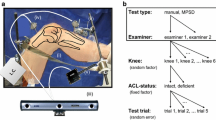Abstract
The objective of this study was to design a navigated mechanized pivot shift test setup and evaluate its repeatability in the ACL-deficient knee. It was hypothesized that translations and rotations measured with the mechanized pivot shift would be more repeatable when compared to those obtained with a manual pivot shift. Twelve fresh frozen cadaveric hip-to-toe whole lower extremities were used for this study. A manual pivot shift test was performed in the intact knee and in the ACL-deficient knee and was repeated three times. A navigation system simultaneously recorded tibial translation and rotation. The mechanized pivot shift test consists of a modified continuous passive motion (CPM) machine and a custom-made foot holder to allow for the application of internal rotation moments at the knee. Valgus moments were achieved by a 45° tilt of the CPM machine with respect to the supine position and a Velcro strap secured across the proximal tibia. The mechanized pivot shift was repeated three times. Repeated measures ANOVA was used to compare manual and mechanized pivot shift testing. An intra-class correlation coefficient (ICC) was used to determine variability within each knee at each testing condition. In the ACL-deficient knee, translation with manual pivot shift testing (11.7 ± 2.6 mm) was significantly higher than with mechanized pivot shift testing (7.4 ± 2.5 mm; p < 0.05). Rotation with the manual pivot shift testing (18.6 ± 5.4°) was also significantly higher than with mechanized pivot shift testing (11.0 ± 2.3°; p < 0.05). The intra-class ICC for translations was 0.76 for manual pivot shift and 0.92 for the mechanized pivot shift test. The intra-class ICC for rotations was 0.89 for manual pivot shift and 0.82 for the mechanized pivot shift test. This study introduced a modified CPM for mechanized pivot shift testing. Although recorded translations and rotations with the mechanized pivot shift test were lower than with manual testing, the clinical advantage of mechanized pivot shift testing is a more repeatable measurement of ATT when compared to manual pivot shift testing. This setup may increase consistency of clinical grading of the pivot shift test.





Similar content being viewed by others
References
Almquist PO, Arnbjornsson A, Zatterstrom R et al (2002) Evaluation of an external device measuring knee joint rotation: an in vivo study with simultaneous Roentgen stereometric analysis. J Orthop Res 20:427–432
Bach BR Jr, Warren RF, Wickiewicz TL (1988) The pivot shift phenomenon: results and description of a modified clinical test for anterior cruciate ligament insufficiency. Am J Sports Med 16:571–576
Bull AM, Earnshaw PH, Smith A et al (2002) Intraoperative measurement of knee kinematics in reconstruction of the anterior cruciate ligament. J Bone Joint Surg Br 84:1075–1081
Colombet P, Robinson J, Christel P et al (2007) Using navigation to measure rotation kinematics during ACL reconstruction. Clin Orthop Relat Res 454:59–65
Galway HR, MacIntosh DL (1980) The lateral pivot shift: a symptom and sign of anterior cruciate ligament insufficiency. Clin Orthop Relat Res 147:45–50
Hefti F, Muller W, Jakob RP et al (1993) Evaluation of knee ligament injuries with the IKDC form. Knee Surg Sports Traumatol Arthrosc 1:226–234
Irrgang JJ, Ho H, Harner CD et al (1998) Use of the international knee documentation committee guidelines to assess outcome following anterior cruciate ligament reconstruction. Knee Surg Sports Traumatol Arthrosc 6:107–114
Katz JW, Fingeroth RJ (1986) The diagnostic accuracy of ruptures of the anterior cruciate ligament comparing the Lachman test, the anterior drawer sign, and the pivot shift test in acute and chronic knee injuries. Am J Sports Med 14:88–91
Kubo S, Muratsu H, Yoshiya S et al (2007) Reliability and usefulness of a new in vivo measurement system of the pivot shift. Clin Orthop Relat Res 454:54–58
Kurosaka M, Yagi M, Yoshiya S et al (1999) Efficacy of the axially loaded pivot shift test for the diagnosis of a meniscal tear. Int Orthop 23:271–274
Lane CG, Warren RF, Stanford FC et al (2008) In vivo analysis of the pivot shift phenomenon during computer navigated ACL reconstruction. Knee Surg Sports Traumatol Arthrosc 16:487–492
Markolf KL, Park S, Jackson SR et al (2008) Simulated pivot-shift testing with single and double-bundle anterior cruciate ligament reconstructions. J Bone Joint Surg Am 90:1681–1689
Musahl V, Bell KM, Tsai AG et al (2007) Development of a simple device for measurement of rotational knee laxity. Knee Surg Sports Traumatol Arthrosc 15:1009–1012
Noyes FR, Grood ES, Cummings JF et al (1991) An analysis of the pivot shift phenomenon. The knee motions and subluxations induced by different examiners. Am J Sports Med 19:148–155
Pearle AD, Solomon DJ, Wanich T et al (2007) Reliability of navigated knee stability examination: a cadaveric evaluation. Am J Sports Med 35:1315–1320
Steckel H, Murtha PE, Costic RS et al (2007) Computer evaluation of kinematics of anterior cruciate ligament reconstructions. Clin Orthop Relat Res 463:37–42
Tashman S, Collon D, Anderson K et al (2004) Abnormal rotational knee motion during running after anterior cruciate ligament reconstruction. Am J Sports Med 32:975–983
Uh BS, Beynnon BD, Churchill DL et al (2001) A new device to measure knee laxity during weightbearing and non-weightbearing conditions. J Orthop Res 19:1185–1191
Zaffagnini S, Bruni D, Martelli S et al (2008) Double-bundle ACL reconstruction: influence of femoral tunnel orientation in knee laxity analysed with a navigation system—an in vitro biomechanical study. BMC Musculoskelet Disord 9:25
Author information
Authors and Affiliations
Corresponding author
Rights and permissions
About this article
Cite this article
Musahl, V., Voos, J., O’Loughlin, P.F. et al. Mechanized pivot shift test achieves greater accuracy than manual pivot shift test. Knee Surg Sports Traumatol Arthrosc 18, 1208–1213 (2010). https://doi.org/10.1007/s00167-009-1004-9
Received:
Accepted:
Published:
Issue Date:
DOI: https://doi.org/10.1007/s00167-009-1004-9




